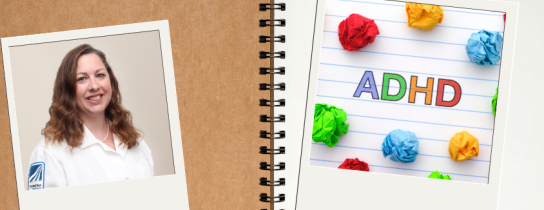
ADHD Awareness in Children
There’s another email from your child’s teacher discussing their behavior in class in your inbox. It mentions their struggles to pay attention, listen properly, and stay seated at their desk. Unlike before, this email ends with the parting words: “I would recommend that you have your child evaluated for ADHD.” You’ve known that your child has trouble staying focused and is easily distracted, but you were hoping that with a little more time they could outgrow it. A wave of emotions overcome you and you just don’t know where to begin. Luckily, Shelley D. Carolan DO, a board-certified pediatrician at Crystal Run Healthcare, is here to walk you through what an ADHD diagnosis looks like for your child.
“First, let’s remove the stigmas associated with ADHD,” said Dr. Carolan, “Many talented and brilliant people have been diagnosed with ADHD, including Simone Biles, Michael Phelps, Bill Gates, and Justin Timberlake, just to name a few. Second, make an appointment with your pediatrician. They are an amazing resource and will help with explaining what an ADHD diagnosis looks like and the steps in the process.”
What Is ADHD?
Attention Deficit Hyperactivity Disorder (ADHD) is a neurodivergent disorder that affects brain development and activity. There are three subtypes – Predominantly Inattentive Subtype, Predominantly Hyperactive Subtype, and Combined Subtype. What symptoms your child shows will determine the subtype of ADHD they have and the best management options.
What are the symptoms?
Symptoms typically fall under one of two categories: Inattention or Hyperactivity and Impulsivity. For symptoms to be considered related to ADHD, they must be present for at least six months and inappropriate for the developmental level of your child. Some of these symptoms include:
Inattention:
- Often easily distracted
- Forgetful in daily activities
- Loses things necessary for activities
- Trouble organizing tasks
- Often does not listen when spoken to directly
- Avoids and dislikes activities that require sustained mental effort
Hyperactivity and Impulsivity:
- Fidgeting
- Cannot stay seated when expected
- Usually unable to play quietly
- Often seems like they are always on the go
- Talks excessively
- Often interrupts others or blurts out answers
“Often, it is the hyperactive and impulsive subtype child that get diagnosed earlier due to disruption in the classroom,” said Dr. Carolan, “but do not overlook that daydreamer with inattentive ADHD. They can be just as severely affected.”
My child has received an ADHD diagnosis? What’s next?
Your child will need accommodations in their classroom so they can learn and prosper. These accommodations can include extended time for tests, homework assignments, motor breaks, preferential seating, and backpack checks. This is possible by requesting accommodations for ADHD. You will most likely need to submit a form to your child’s school, usually a 504 Plan or IEP. The right medication can also be a game-changer for many children. There are many different medications used to treat ADHD symptoms. Finding the right one is individual to each child, and pediatricians at Crystal Run Healthcare can work with you to discuss your options regarding your child’s ADHD diagnosis.
“Remember, you are your child’s number one advocate,” said Dr. Carolan, “Do not be afraid to speak up and fight for what your child needs. With your love, support, and partnership with their school, your child can thrive.”
Shelley D. Carolan DO is a Board-Certified Pediatrician at Crystal Run Healthcare. Dr. Carolan earned her BS in Biology at The College of New Jersey in Ewing, NJ, and her Doctorate of Osteopathic Medicine at the New York College of Osteopathic Medicine in Old Westbury, NY. She completed her Pediatric Residency and Chief Residency at UMDNJ - New Jersey Medical School in Newark, NJ. Dr. Carolan’s clinical interests include developmental pediatrics and the integration of primary care and behavioral health. Dr. Carolan is currently seeing patients in Haverstraw.
Additional Resources:

 Optum Radiology at Crystal Run Healthcare
Optum Radiology at Crystal Run Healthcare Request medical records online
Request medical records online